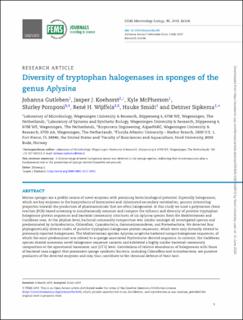| dc.contributor.author | Gutleben, Johanna | |
| dc.contributor.author | Koehorst, Jasper J | |
| dc.contributor.author | McPherson, Kyle | |
| dc.contributor.author | Pomponi, Shirley | |
| dc.contributor.author | Wijffels, Rene Hubertus | |
| dc.contributor.author | Smidt, Hauke | |
| dc.contributor.author | Sipkema, Detmer | |
| dc.date.accessioned | 2020-06-17T12:32:49Z | |
| dc.date.available | 2020-06-17T12:32:49Z | |
| dc.date.created | 2019-10-21T13:45:26Z | |
| dc.date.issued | 2019 | |
| dc.identifier.citation | Gutleben, J., Koehorst, J. J., McPherson, K., Pomponi, S., Wijffels, R. H., Smidt, H. & Sipkema, D. (2019). Diversity of tryptophan halogenases in sponges of the genus Aplysina. FEMS Microbiology Ecology, 95(8). doi: | en_US |
| dc.identifier.issn | 1574-6941 | |
| dc.identifier.uri | https://hdl.handle.net/11250/2658489 | |
| dc.description.abstract | Marine sponges are a prolific source of novel enzymes with promising biotechnological potential. Especially halogenases, which are key enzymes in the biosynthesis of brominated and chlorinated secondary metabolites, possess interesting properties towards the production of pharmaceuticals that are often halogenated. In this study we used a polymerase chain reaction (PCR)-based screening to simultaneously examine and compare the richness and diversity of putative tryptophan halogenase protein sequences and bacterial community structures of six Aplysina species from the Mediterranean and Caribbean seas. At the phylum level, bacterial community composition was similar amongst all investigated species and predominated by Actinobacteria, Chloroflexi, Cyanobacteria, Gemmatimonadetes, and Proteobacteria. We detected four phylogenetically diverse clades of putative tryptophan halogenase protein sequences, which were only distantly related to previously reported halogenases. The Mediterranean species Aplysina aerophoba harbored unique halogenase sequences, of which the most predominant was related to a sponge-associated Psychrobacter-derived sequence. In contrast, the Caribbean species shared numerous novel halogenase sequence variants and exhibited a highly similar bacterial community composition at the operational taxonomic unit (OTU) level. Correlations of relative abundances of halogenases with those of bacterial taxa suggest that prominent sponge symbiotic bacteria, including Chloroflexi and Actinobacteria, are putative producers of the detected enzymes and may thus contribute to the chemical defense of their host. | en_US |
| dc.language.iso | eng | en_US |
| dc.publisher | Oxford | en_US |
| dc.rights | Navngivelse 4.0 Internasjonal | * |
| dc.rights.uri | http://creativecommons.org/licenses/by/4.0/deed.no | * |
| dc.title | Diversity of tryptophan halogenases in sponges of the genus Aplysina | en_US |
| dc.type | Peer reviewed | en_US |
| dc.type | Journal article | en_US |
| dc.description.version | publishedVersion | en_US |
| dc.rights.holder | © FEMS 2019 | en_US |
| dc.subject.nsi | VDP::Matematikk og Naturvitenskap: 400::Basale biofag: 470::Generell mikrobiologi: 472 | en_US |
| dc.source.pagenumber | 1-15 | en_US |
| dc.source.volume | 95 | en_US |
| dc.source.journal | FEMS Microbiology Ecology | en_US |
| dc.source.issue | 8 | en_US |
| dc.identifier.doi | 10.1093/femsec/fiz108 | |
| dc.identifier.cristin | 1739073 | |
| dc.relation.project | EC/FP7/607786 | en_US |
| dc.description.localcode | Unit Licence Agreement | en_US |

